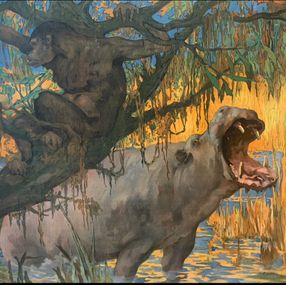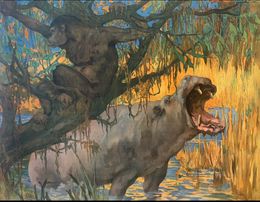
Presentation
The HENRY family has been based in NANCY and BAYON (Meurthe et Moselle) since 1815.
Edouard is the fifth child out of nine; his father, Charles Jean-Baptiste HENRY (1834-1883) was director of the Nancy branch of the Banque de France; his mother, Marie-Charlotte BAUDOT remained a widow in 1883 and raised her children alone; she lives on her income.
Born in 1871 in NANCY, Edouard Louis HENRY was inspired from his youth by the harsh countryside of Lorraine where, although Parisian by adoption, he spent long months until the First World War.
Edouard, who, at a very young age, had a very good disposition for drawing, came to settle in Paris in 1890, first at 9, rue Brochard de Charon, then, in 1893, at 4bis, rue Gustave Doré; his mother returns to Bayon, where he will return for all his holidays.
In 1892, he enrolled at the Atelier Julian, then considered an excellent painting school. There he met another Nancy, Henry Guinier. He took lessons from Jules Lefebvre and Tony Robert-Fleury. He created a number of plates for the Atlas of the anatomy of the forms of the human body for the use of painters and sculptors published by Doctor Fau. A pupil of the JULIAN workshop, he always exhibited at the Société Nationale des Beaux-Arts, under his artist name: Edouard Henry-Baudot, of which he was successively an associate member, a member in 1910, then Secretary of the Committee in 1922. left the Academy in 1895.
From this time, Edouard knows that he will be an artist-painter; The name HENRY is very common in the East of France; this is why, in 1893 by notarial deed his grandfather Jules Charles Baudot authorizes him to add to his patronymic name of Henry that of Baudot, to be legally called HENRY-BAUDOT.
The regularization by the Council of State will finally be made only in 1957 by Jacques Henry-Baudot, his only son, so that during 3 generations the family was called legally: HENRY said HENRY-BAUDOT.
In 1897, Edouard was therefore 26 years old when he painted “Nymphe".
Edouard Henry regularly spends his holidays in Bayon. There he met the Roussel families (parents of the musician Albert Roussel) and Lagrésille. An idyll is tied between Edouard and Laure Lagrésille, a wealthy young girl directly descended from the Counts of Grésille. They married on August 31, 1893. The couple moved to Paris, rue Juliette Lambert, then 85 avenue de Villiers. They lived comfortably on income mainly from Laure (she inherited the Bayon property in 1893, buildings in Nancy and securities, for more than 300,000 francs at the time.
Shortly after their marriage, they sold part of Laure's assets and bought from the painter Lortat-Jacob a plot of land at 19 Boulevard Berthier (Paris XVII), a newly created boulevard, on which they built a building comprising 4 artists' studios with outbuildings. Three will be rented, and the one on the ground floor will be occupied by Edouard until 1937.
The couple left Avenue de Villiers to settle in Sceaux, thus becoming closer to the family of Jacques, their only son, born in 1905.
In 1907, he obtained from the Museum of Natural History an authorization to draw, model and photograph the menagerie and the galleries of the Museum. In 1910 he went from member to associate in the SNBA. He meets Armand Point and Lucien Madrassi. Léon Couturier (1842-1935) dedicated three drawings to him, including one "on board the Crown".
In 1912, he discovered Brittany with his friend Albert Roussel. In 1914 he was hired by General Galliéni's staff to survey the front lines, which were essential for adjusting artillery fire. In particular, he engraves two stamps celebrating the victory for the Post Office.
During one of these risky operations, within range of enemy fire, day and night, he is driven by his driver on all motorable roads, and is the victim of a serious accident. At the sudden start of his car, threatened by enemy fire, he fell backwards very violently and suffered serious back injuries from which he would suffer until the end of his days. During his long convalescence he will come to rest in Paramé in 1916 and will be able to gradually resume work on modest dimensions because he struggles to remain upright for a long time, like brushing too large surfaces.
From the consequences of the war, his health unfortunately became very poor, and it was while convalescing that he returned to Brittany to Belle Ile with Albert Roussel between 1918 and 1930, where he found Henry Guinier. They find other artists at the manor of Goulphar. Landscapes, seascapes, sunken paths, old stones, domestic animals are the subjects of a large number of pen and blood drawings, watercolours, gouaches, always executed in the heart of nature, while in the studio (Boulevard Berthier in Paris) his creative imagination leads him to compositions often inspired by mythology.
Edouard's works sold well, very often to wealthy breeders from South America, who came to spend the winter season in Paris. He exhibits every year at the Salon of the National Society of Fine Arts (references on the site of the Réunion des Musées Nationaux).
Edouard HENRY-BAUDOT will definitively stop painting during the Second World War. Ruined, old, he lives on his wits and suffers cruelly from hunger and cold. The compositions for "Ovid's Metamorphoses" mentioned above are most certainly his last achievements.
After hard times during the war of 39-45 and his wife died in 1945, his health forced him to retire in the south of France, he retired to a boarding house in Théoule/mer (Alpes Maritimes) where he died in 1953 at the age of 82.
Edouard Henry-Baudot in his studio on boulevard Berthier in Paris
What were Edouard HENRY-BAUDOT's main sources of inspiration?
The most important is probably mythology, a real passion for this cultured man, nourished by classical culture. He devoted many compositions to her (including, of course, “Nymphe"); his work will end with twelve gouaches on cardboard intended to illustrate a work on "Ovid's metamorphoses" (1943/1944), which unfortunately will never see the light of day.
Many critics saw in Edouard an animal painter. He often goes to the Jardin des Plantes to observe wild animals, to the Museum to study their anatomy and skeleton. Many works reflect this interest: a superb series of tigers installed in a luxuriant setting, horses at work, etc.
From 1912, he very often traveled to Brittany, southern Finistère (Raguenès) and Belle Ile, where he met, among other artists, his friend the musician Albert ROUSSEL. He produced large compositions there (gouaches on stretcher) as well as numerous pen and Indian ink drawings. The solitary residence of the castle of Goulphar made him discover the charm and the harshness of Brittany.
As the art critic Maurice GUILLEMOT wrote of him on the occasion of his exhibition in 1922: "HENRY-BAUDOT only obeys his whim of the moment, whether he is a figurist, animal painter, decorator, which he uses to express himself in oil, distemper, gouache, watercolor or pen, he always remains in the lofty spheres of inspiration".
Edouard HENRY-BAUDOT was certainly also influenced by the Japanese art of printmaking. The family still owns many of the prints he collected; and he had as a pupil a young Japanese painter, Takeshiro Kanokogi (1874-1941) who dedicated a work "to my master and friend Mr. EH Baudot".
Finally, the female body is a great source of inspiration, certainly born during her studies at the Julian workshop. He welcomes many models in his studio on Boulevard Berthier.
Edouard Henry-Baudot rubbed shoulders with many artists who left him specially dedicated works and we believe that he was remunerated by works, in particular those of Eugène Delacroix.
We have identified:
A Parrot: 35*35 cm: gouache drawn by Adolphe Thomasse France (1850 - 1930) offered and dedicated to "friend Edouard Henry-Baudot"
A Stamp: 20*25 cm: engraving by Daniel Brunet (1882-1943) entitled: sooner or later offered to Edouard
The old market hall in Einville au Jard: 35*45 cm Engraving of The old market hall in Einville au Jard engraved by Paul Emile Colin (16/08/1867 – 10/1949) signed and offered to Edouard
Reprisals by Pierre Georges Jeanniot: 45*60 cm Engraving "Reprisals" by Pierre Georges Jeanniot (1848-1934) trial proof offered and dedicated to Edouard Henry-Baudot, his friend
Apollo: 30*55 cm Sanguine “Apollo and his lyre" drawn by Armand P? and offered to Edward
7th proof out of 50 of an engraving by Henri Amédée-Wetter: 45*60 cm Engraving by Henri Amédée-Wetter (1869-1929): the naiads offered by H. A W. to Edouard (wood engraving?) signed
Naked woman touching her leg: 45*60 cm Sanguine drawing by Emile Quentin Brin (1863-1930) offered to Edouard
Naked woman lying on a bed signed: 30*35 cm Sanguine signed offered to Edouard by an artist whose signature we have not been able to identify. If anyone knows this signature, please send the identification by the contact of the site
Naked woman: 35*50 cm Charcoal Naked woman drawn by Emile Gaudissard (1872-1956) offered to Edouard Henry-Baudot
4 sketches by Alfred Hubert Donat Lagache (1875-1959) met at the fine arts and offered to Edouard
Head of a man dedicated by Ludovic LUCIEN MADRASSI (1881-1956)
Portrait of a man signed J DAVID NITLY? offered to Edward
A Silhouette signed by Julien le Bordays offered to Edouard
Two women in a boat drawn by Henry Amédée Wetter (1869-1929) + a watercolor dated 1919 representing a colorful landscape
A Cavalier signed by Henry Jeanson dedicated to the attention of Edouard
Harvest festival characters drawn by V. Pannat (or Vitanni or V. Paumi)
A Cavalier signed by O. de TH.
Cavalier at war drawn by Eug. Delacroix
A manuscript Poem signed Alphonse Karn (or Kam or Kar)
Two wanderers who clink glasses drawn by H.DREY JRY (Try Trey or Trej)
Deadly burden drawn by Eugene Ladel (or Cadel)
Egg harvester designed by L. Clermont dated 1924
Actress drawn by Hugues de Beaumont (1873-1947)
“War crimes" engraving by Pierre Georges Jeanniot (1848-1934)
The wild coast by Takeshiro Kanokogi (1874-1941) "from Japan" dedicated "to my master and friend Mr. EH Baudot"

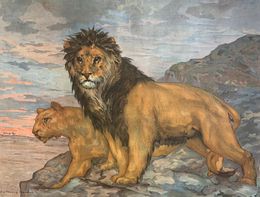


Les animaux sauvages_Vll
Henry Baudot
Print - 81 x 97 x 0.5 cm Print - 31.9 x 38.2 x 0.2 inch
$2,997
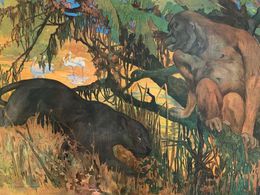

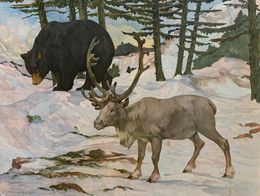

Discover our selections of works by artists
What are their 3 main works?
When was Henry Baudot born?
